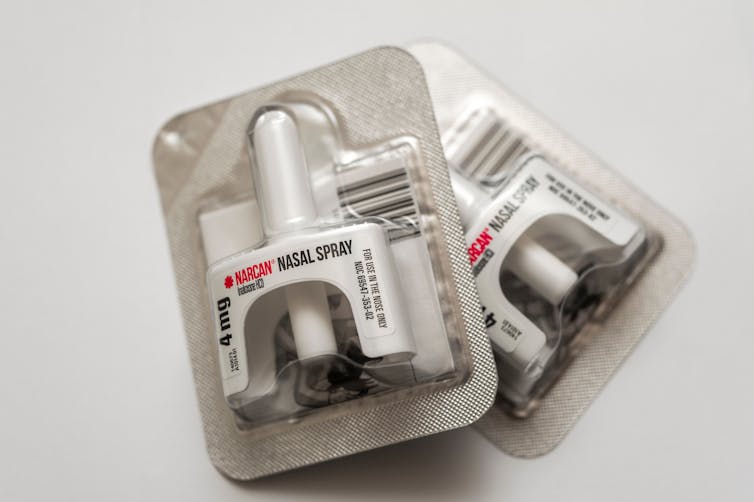Suzanne Nielsen, Deputy Director, Monash Addiction Research Centre
Richard Armour, PhD Candidate, Faculty of Medicine, Monash University
A new group of drugs called nitazenes has been detected in Australia. They’ve been sold as heroin, as well as other drugs like ketamine.
Concerns about the potential harms associated with these drugs, and users not knowing what they’re taking, have led to government health alerts and coroners’ recommendations for drug-checking.
Nitazenes are similar to the drug fentanyl, which has led to unprecedented deaths in North America. Fentanyl is the prescription opioid that caused Prince’s death in 2016. Some are similar to fentanyl in strength, while others can be up to 50 times stronger than fentanyl.
Australia has an opportunity to learn from the North American experience of severe harms related to a highly contaminated drug supply, prior to these drugs becoming common here.
What’s the difference between heroin, fentanyl, and nitazenes?
Fentanyl and nitazenes are highly-potent “synthetic” opioids, meaning they’re made in a laboratory. This differs from morphine or heroin, which come from the opium poppy.
Although fentanyl is a prescription opioid, most fentanyl in the US drug market is made illegally in labs. Illegally-manufactured fentanyl has had catastrophic impacts in North America, accounting for most drug deaths in the US and Canada.
Read more: Getting ahead of the fentanyl threat: We need to act now to avoid a public health disaster
Fentanyl is estimated to be up to 50 times more potent than heroin with a fast onset of action, reducing the time available to respond to an overdose.
To date, there’s been limited evidence of fentanyls being widely available in Australia, with declining Australian deaths due to fentanyls.

However, there are concerns this new class of drugs, the nitazenes, may be different. Nitazenes were developed and tested in the 1950s by pharmaceutical companies, but unlike fentanyl, did not proceed to therapeutic use due to their poor safety profile.
Nitazenes have caused increasing deaths in the United Kingdom and the US. Some of the first nitazenes identified included isotonitazene (2019) and metonitazene (2020). Several compounds have now been brought under international drug control.
Nitazenes vary in strength, with some being lower in potency than fentanyl, while most are similar to or stronger than fentanyl.
In contrast to fentanyl, where medical use has led to a good understanding of its effects, there’s comparatively limited research on nitazenes. Limited ability to detect nitazenes has also hampered our knowledge and understanding of the extent of harms related to their use.
Globally, and in Australia, nitazenes have appeared in falsified pharmaceutical products (packaged to look like pharmaceutical pain medicines) and as contaminants in drugs such as heroin, methamphetamine, MDMA, and ketamine.
There also reports of people knowingly purchasing nitazenes online.
A broad range of people could be affected by accidentally or intentionally taking nitazenes. This ranges from people who use drugs occasionally at music festivals, to people who regularly inject drugs.
This means a wide range of strategies will be needed to meet the needs of these different populations.
What can we do about them?
A range of proposed public health responses to the threat of fentanyl could be applied to nitazenes. Australia is yet to implement or fully upscale most of these harm reduction responses, but they would work for nitazenes. These include:
Drug checking
Testing drugs for nitazenes or other toxic contaminants prior to use is an option in Canberra and parts of Queensland. A small drug-checking pilot is also underway in Sydney, but for most of Australia, drug-checking isn’t available.
Other options include instant drug-checking strips that can be used at home. An instant test strip for nitazenes has recently been made available overseas, but it may not identify all drugs of concern.
Instant testing strips can be inaccurate, with false positives results related to the presence of other commonly-used substances such as MDMA, and they can be hard to read correctly. For these reasons, we don’t know how helpful they will be in Australia yet.
Supervised injecting rooms
Increasing access to supervised injecting facilities means that if someone injecting drugs inadvertently ingests a nitazene, medical care is immediately on hand. Antidotes such as naloxone can be quickly administered alongside other life-saving care.
Read more: Medically-supervised injecting rooms and the politics of illicit drug policy
Two such facilities operate in Melbourne and Sydney, so we would need many more locations to be established in different geographic areas to be effective if nitazenes become an issue in Australia.
Access to naloxone
Naloxone is a medicine that reverses the effects of opioids, and has been used in hospitals and by paramedics for decades to treat overdose. We have good evidence that trained laypeople can also administer naloxone to treat overdose successfully.
Increasing access to take-home naloxone, alongside opioid overdose education is critical.
People may inadvertently consume nitazenes contained in drugs sold as stimulants. This means having naloxone in a wide range of settings, including nightclubs, festivals and music events, will be vital to respond quickly to unexpected overdoses.

Drug education
As many drug-related deaths occur in people’s homes, education about the signs and symptoms of opioid overdose, and providing naloxone to people who use stimulants or other drugs, is essential.
For people who regularly use or inject drugs, existing harm-reduction services are ideally placed to deliver messaging regarding nitazenes, including the heightened severity of overdose risk, and current public health alerts about these substances.
Access to opioid dependence treatments such as methadone and buprenorphine can be life-saving, and could also be expanded.
Nitazenes present a unique threat in Australia. But drug-checking, increasing supervised drug consumption facilities and expanding take-home naloxone with overdose education can help reduce harm from these and other drugs in Australia.
This article originally appeared on The Conversation.






